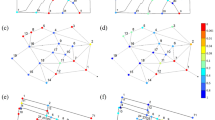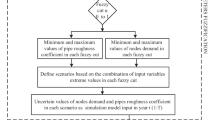Abstract
The variability of flow regimes in on demand pressurized irrigation systems leads to uncertainty in head at the nodes affecting the system performance, and thus it should be considered when designing and/or rehabilitating water distribution systems. Based on these considerations a new approach for the optimization of on demand pressurized irrigation systems is presented combining the minimization of cost with the maximization of reliability taking into account the stochastic variability of the flows into each section of the network. The new model, Clément and the cumulated random generated discharges model (FAO model) were applied to three pressurized irrigation networks of different dimensions (large, medium and small) operating on demand in Southern Italy. The optimization algorithm used in all the cases is the Labye iterative discontinuous method, a formulation of the dynamic programming. The results of the different models were compared showing that the cost of the optimal network calculated using the new model was reduced by more than 20%, without any significant decrease of the system reliability or reduction of the network capacity.























Similar content being viewed by others
Abbreviations
- C :
-
total number of generated configurations
- d :
-
hydrant nominal discharge, l s−1
- dH :
-
variation of the pressure head, m
- dP :
-
minimum cost variation, Euro
- D s :
-
commercial pipe diameter, m
- dY:
-
variation of the friction loss, m
- EH :
-
minimum value of the excess head prevailing in all the nodes where the head changes, m
- F :
-
set of all unsatisfactory states
- H :
-
pressure head, m
- Ih :
-
hydrant operation index
- Ip :
-
pressure head index
- J :
-
friction loss of the pipe diameter per unit length, m m−1
- L :
-
generic length, m
- M :
-
pathway starting form the network upstream end
- m :
-
number of hydrants simultaneously operating
- N :
-
total number of hydrants
- P :
-
cost of the pipe diameter, Euro
- Q :
-
discharge, l s−1 or m3 s−1
- Re :
-
reliability
- S :
-
set of all satisfactory states
- SN :
-
sub-network
- SN*:
-
elementary scheme
- u :
-
dimensional coefficient of resistance, m−1 s2
- v :
-
flow velocity, m s−1
- Y :
-
head losses, m
- Y*:
-
the value of the head loss corresponding to the largest diameter over its entire length if the section has two diameters, or the successive greater diameter if the section has only one diameter, m
- Z 0 :
-
upstream piezometric elevation, m a.s.l
- β:
-
coefficient
- ΔYi :
-
the minimum value of (Yk,i - Y*)
- ΔZ :
-
the difference between the upstream piezometric elevation for a particular flow regime, and the piezometric elevation, effectively available at the upstream end of the network.
- γ :
-
roughness parameter of Bazin, m0.5
- h :
-
hydrant
- i :
-
iteration
- in :
-
initial
- j :
-
the most unfavorable hydrant
- k :
-
section of the network
- max :
-
maximum
- min :
-
minimum
- r :
-
configuration
- sys :
-
system
- t :
-
time
References
Ait Kadi M, Abdellaoui R, Oulhaj A, Essafi B (1990) Design of large scale collective sprinkler irrigation projects for on demand operation: a holistic approach. In: ICID fourteenth international congress on irrigation and drainage. Rio de Janeiro, Vol. 1D, pp 59–78
Alperovits E, Shamir U (1977) Design of optimal water distribution systems. Water Resour Res 13(6):885–900
Babayan A, Kapelan Z, Savic D, Walters G (2005) Least cost design of water distribution networks under demand uncertainty. J Water Res Pl-ASCE 131(5):375–282
Bao I, Mays LW (1990) Model for water distribution system reliability. J Hydraul Eng ASCE 116(9):1119–1137
Bargiela A, Hainsworth G (1989) Pressure and flow uncertainty in water system. J Water Res Pl-ASCE 115(2):212–229
Calejo MJ, Lamaddalena N, Teixeira JL, Pereira LS (2008) Performance analysis of pressurized irrigation systems operating on demand using flow-driven simulation modelling. Agr Water Manag 95(2):154–162
Chung G, Lansey K (2008) Application of the shuffled frog leaping algorithm for the optimization of a general large-scale water supply system. Water Resour Manag 23:797–823
Clément R (1966) Calcul des débits dans les réseaux d’irrigation fonctionnant à la demande. La Houille Blanche 5:553–575
Duan N, Mays LW (1990) Reliability analysis of pumping systems. J Hydraul Eng ASCE 116(2):230–248
Germanopoulos G, Jowitt P W, Lumbers J P (1986) Assessing the reliability of supply and level of service for water distribution systems. In: Proceedings of the institution of Civil Engineers. Part 1, 80, Apr., pp 413–428
Goulter I (1995) Analytical and simulation models for reliability analysis for water distribution systems. In: Cabrera E, Vela AF (eds) Improving efficiency and reliability in water distribution systems. Kluwer, London, pp 235–266
Goulter I, Bouchard F (1990) Reliability – constrained pipe network model. J Hydraul Eng ASCE 116(2):211–266
Goulter I, Goals A (1986) Quantitative approaches to reliability assessment in pipe networks. J Transp Eng-ASCE 112(3):287–301
Hashimoto T (1980) Robustness, reliability, resiliency and vulnerability criteria for planning water resources system. Dissertation, Cornell University
Hashimoto T, Stedinger JR, Loucks DP (1982) Reliability, resiliency and vulnerability criteria for water resources system performance evaluation. Water Resour Res 18(1):14–20
Khadra R, Lamaddalena N (2006) A simulation model to generate the demand hydrograph in large scale irrigation systems. Biosyst Eng 93(3):335–346
Khadra R, Lamaddalena N (2010) Development of a decision support system for irrigation systems analysis. Water Resour Manag 24(12):3279–3297
Khomsi D, Walters GA, Thorley ARD, Quasar D (1996) Reliability tester for water – distribution networks. J Comput Civil Eng -ASCE 10(1):10–19
Labye Y (1981) Iterative discontinuous method for networks with one or more flow regimes. In: ICID International workshop on systems analysis of problems in irrigation, drainage and flood control. New Delhi, pp 31–40
Labye Y, Olson M A, Galand A, Tsiourtis N (1988) Design and optimization of irrigation distribution networks. FAO, Rome. FAO Irrigation and Drainage Paper n. 44
Lamaddalena N (1995) Un modello di simulazione per l’analisi del funzionamento delle reti irrigue collettive. Riv di Ing Agr 4:221–229
Lamaddalena N (1996) Sulla ottimizzazione dei diametri in una rete irrigua con esercizio alla domanda. Riv di Ing Agr 1:12–19
Lamaddalena N (1997) Integrated simulation modelling for design and performance analysis of on-demand pressurized irrigation systems. Dissertation, Technical University of Lisbon
Lamaddalena N, Pereira LS (2007a) Assessing the impact of flow regulators with a pressure-driven performance analysis model. Agr Water Manag 90(1):28–35
Lamaddalena N, Pereira LS (2007b) Pressure-driven modeling for performance analysis of irrigation systems operating on demand. Agr Water Manag 90(1):36–44
Lamaddalena N, Piccinni AF (1993) Sull’utilizzo delle curve caratteristiche indicizzate di una rete irrigua per il dimensionamento degli impianti di sollevamento. Riv di Ing Agr 3:129–135
Lamaddalena N, Sagardoy JA (2000) Performance analysis of on-demand pressurized irrigation systems. FAO, Rome. FAO Irrigation and Drainage Paper n. 59
Lansey KE, Mays LW (1989) Optimization model for water distribution system design. J Hydraul Eng ASCE 115(10):1401–1418
Li D, Dolezal T, Hiames Y (1993) Capacity reliability of water distribution networks. Reliab Eng Syst Saf 42(1):29–38
Mays LW (1996) Review on reliability analysis of water distribution systems. In: Tickle et al (eds) Stochastic hydraulics. Balkema, Rotterdam, pp 53–62
Ormsbee L, Kessler A (1990) Optimal upgrading of hydraulic network reliability. J Water Res Pl-ASCE 116(6):784–802
Park H, Leibman J (1993) Redundancy-constrained minimum-cost design of water distribution network. J Water Res Pl-ASCE 119(1):83–98
Raad D, Sinske A, van Vuuren J (2009) Robust multi-objective optimization for water distribution system design using a meta-metaheuristic. Int Trans Op Res 16:595–626
Savic D, Walters G (1997) Genetic algorithms for least-cost design of water distribution networks. J Water Res Pl-ASCE 123(2):66–77
Simpson AR, Dandy GC, Murphy LJ (1994) Genetic algorithms compared to other techniques for pipe optimization. J Water Res Pl-ASCE 120(4):423–443
Su Y, Mays LW, Duan N, Lansey K (1987) Reliability – based optimization for water distribution system. J Hydraul Eng ASCE 113(12):589–596
Wagner JM, Shamir U, Marks DH (1988a) Water distribution reliability: analytical methods. J Water Res Pl-ASCE 114(3):253–275
Wagner JM, Shamir U, Marks DH (1988b) Water distribution reliability: simulation methods. J Water Res Pl-ASCE 114(3):276–292
Wu SJ, Yoon YH, Quimbo R (1993) Capacity-weighted water distribution system reliability. Reliab Eng Syst Saf 42(1):39–46
Xu C, Goulter IC (1996) Uncertainty analysis of water distribution networks. In: Tickle A et al (eds) Stochastic hydraulics ‘96. Balkema, Rotterdam, pp 609–616
Xu C, Goulter IC (1997) Reliability assessment of water distribution networks using the first – order reliability – method. In: English M and Szollosi – Nagy A (eds) Managing Water: Coping with scarcity and abundance. ASCE, pp 429–434
Xu C, Goulter IC (1998) Probabilistic model for water distribution reliability. J Water Res Pl-ASCE 124(4):218–228
Xu C, Goulter IC (1999) Reliability-based optimal design of water distribution networks. J Water Res Pl-ASCE 125(6):352–362
Acknowledgement
The authors wish to acknowledge Dr. Alessandra Scardigno, researcher at the Mediterranean Agronomic Institute of Bari, who contributed in tuning up the modeling approach.
Author information
Authors and Affiliations
Corresponding author
Rights and permissions
About this article
Cite this article
Lamaddalena, N., Khadra, R. & Tlili, Y. Reliability-Based Pipe Size Computation of On-Demand Irrigation Systems. Water Resour Manage 26, 307–328 (2012). https://doi.org/10.1007/s11269-011-9919-6
Received:
Accepted:
Published:
Issue Date:
DOI: https://doi.org/10.1007/s11269-011-9919-6




